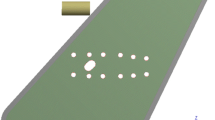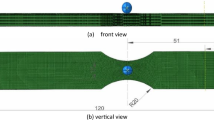Using ANSYS/LS-DYNA software and plastic follow-up hardening constitutive model, a simulation model of foreign object impact damage of the first stage TC4 titanium alloy rotor blade of an aero-engine low-pressure compressor was established. The correctness of the finite element model is verified by the impact test of flat specimens. Furthermore, considering the centrifugal prestress, the damage caused by sandstone impacting rotor blades during the taxiing of the aircraft is simulated. The damage assessment results are compared with those obtained without considering the centrifugal prestress. The main findings imply that for the blade inlet edge located 392.85 mm from the engine shaft, the critical condition for producing a notch is that the sandstone with a diameter of 1.1 mm hits the inlet edge at a relative speed of 442.5 m/s. With the increased gravel radius, the angle between the direction of gravel impacting blade and engine shaft, the relative kinetic energy, impact force, and notch depth all increase exponentially, while the impact duration grows via the quadratic law, and the maximum width of the notch increases linearly. For the sandstone radius between 0.55 and 2.4 mm, the notch depth is less than the notch width. These findings can guide the judgment of blade accident causes or symptoms and have theoretical significance for fatigue design of blades with the foreign object damage account.










Similar content being viewed by others
References
D. Nowell, P. Duo, and I. F. Stewart, “Prediction of fatigue performance in gas turbine blades after foreign object damage,” Int. J. Fatigue, 25, Nos. 9–11, 963–969 (2003).
X. Chen, “Foreign object damage on the leading edge of a thin blade,” Mech. Mater., 37, No. 4, 447–457 (2005).
B. L. Boyce, X. Chen, J. W. Hutchinson, and R. O. Ritchie, “The residual stress state due to a spherical hard-body impact,” Mech. Mater., 33, No. 8, 441–454 (2001).
P. Duo, J. Liu, D. Dini, et al., “Evaluation and analysis of residual stresses due to foreign object damage,” Mech. Mater., 39, No. 3, 199–211 (2007).
S. M. Marandi, K. Rahmani, and M. Tajdari, “Foreign object damage on the leading edge of gas turbine blades,” Aerosp. Sci. Technol., 33, No. 1, 65–75 (2014).
C. Liu, Z. H. Zhao, and W. Chen, “Investigations into simulation test and fatigue strength of foreign object damage of blades,” J. Propul. Technol., 35, No. 3, 403–407 (2014).
S. Y. Oakley and D. Nowell, “Prediction of the combined high- and low-cycle fatigue performance of gas turbine blades after foreign object damage,” Int. J. Fatigue, 29, No. 1, 69–80 (2007).
Z. Q. Bao, X. T. Hu, and Y. D. Song, “Effect of foreign object damage at different impact angles on high cycle fatigue strength of TC4 titanium alloys,” J. Aerosp. Power, 30, No. 9, 2226–2233 (2015).
J. S. Li, Q. Chai, B. Y. Yang, et al., “Impact damage on one kind of aero-engine compressor blade from steel sphere,” J. Air Force Eng. University (Natural Science Edition), 14, No. 6, 5–8 (2013).
Q. Chai, J. S. Li, B. Y. Yang, et al., “Effects of foreign object shape to the aero-engine compressor blade impacted damage,” J. Appl. Mech., 31, No. 6, 5–8 (2014).
J. L. Hamrick, II, Effects of Foreign Object Damage from Small Hard Particles on the High Cycle Fatigue Life of Ti-6Al-4V, Ph.D Thesis (1999).
C. M. Martinez, D. Eylon, T. Nicholas, et al., “Effects of ballistic impact damage on fatigue crack initiation in Ti–6Al–4V simulated engine blades,” Mater. Sci. Eng., 325, Nos. 1–2, 465–477 (2002).
D. M. Yin, L. F. Qian, Y. D. Xu, and L. M. Chen, “Simulation and analysis of blades damaged by sandstone,” J. Nanjing University of Science and Technology (Natural Science), 32, No. 5, 536–539 (2008).
J. O. Hallquist, LS-DYNA Theory Manual, Livermore Software Technology Corporation (2006),
G. F. Zhu, C. W. Li, X. L. Wu, et al., “The TC4 alloys parameter inversion of Cowper–Symonds model,” J. Appl. Mech., 31, No. 6, 5–8 (2014).
B. Y. Yang, Q. Chai, C. W. Li, et al., “Estimation of the velocity for foreign object that impact the rotary blade of aero-engine,” J. Aerosp. Power, 32, No. 12, 2842–2847 (2017).
Acknowledgments
The authors gratefully acknowledge the financial support of the National Natural Science Foundation of China (51575524 and 51601221), Natural Science Basis Research Plan in the Shaanxi Province of China (2020JM-635 and 2020GY-190), and Scientific Research Project of Youth Innovation Team Construction of Shaanxi Provincial Department of Education (21JP105).
Author information
Authors and Affiliations
Corresponding author
Additional information
Translated from Problemy Mitsnosti, No. 2, p. 104, March – April, 2022.
Rights and permissions
About this article
Cite this article
Li, C.W., Miao, Z., Yang, B.Y. et al. Study on Foreign Object Damage Law of Titanium Alloy Blade of an Aero-Engine Impacted by Sandstone. Strength Mater 54, 292–301 (2022). https://doi.org/10.1007/s11223-022-00405-3
Received:
Published:
Issue Date:
DOI: https://doi.org/10.1007/s11223-022-00405-3




